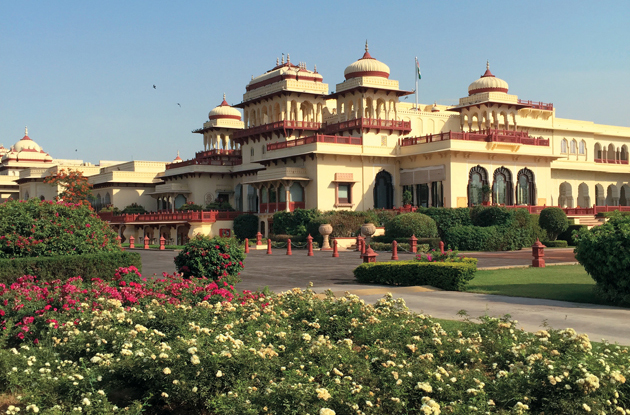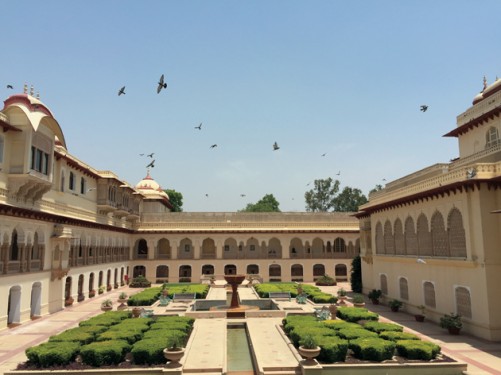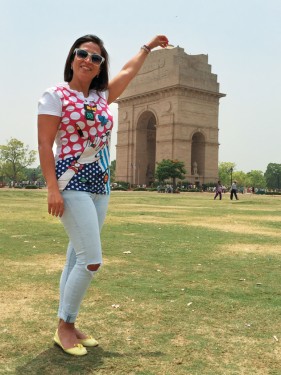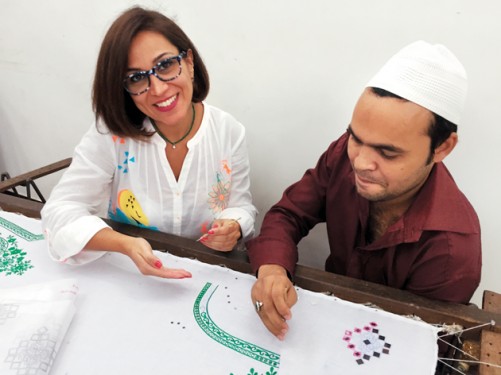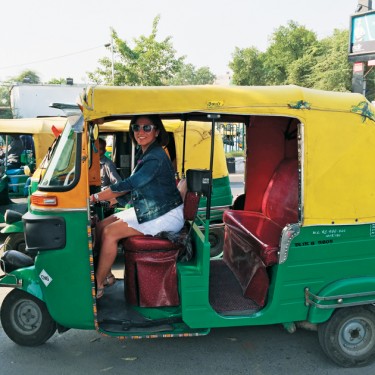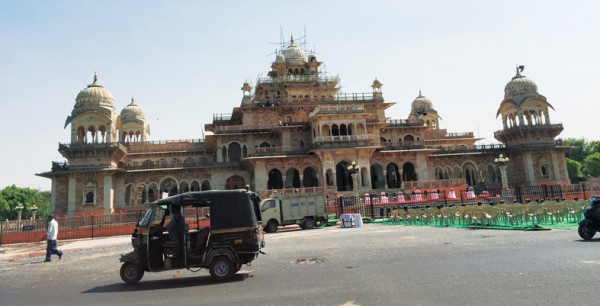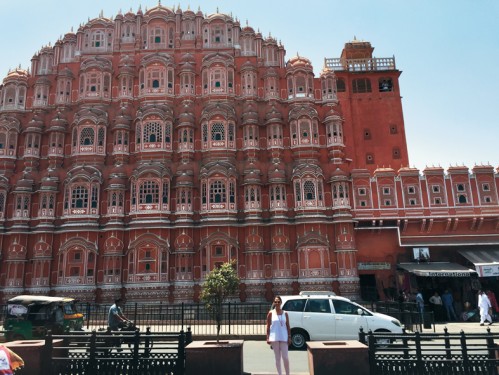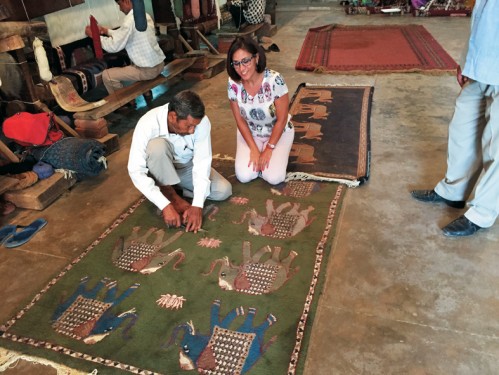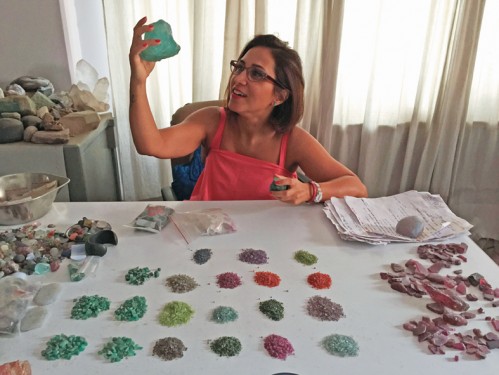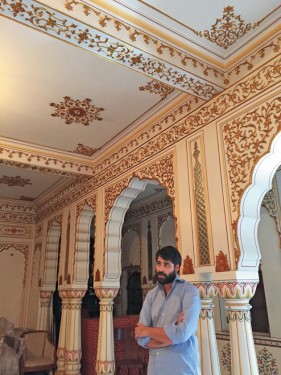Prestige issue 269-270, Dec. 2015- Jan. 2016
Travel by Nivine Maktabi
This trip is very dear to my heart as it marked a big moment in my childhood. It was back in 1986 when my late father planed our New Year holiday. We flew from Beirut to Dubai, with only few hotels like the Intercontinental and one mall called Al Ghorair. I was curious at a young age and everything fascinated me and that’s why I remember the trip very vividly. It was also my first time I sipped the traditional Arabic Gulf coffee full of cardamom. Today this type of coffee is still my favorite when I travel to this part of the world and to my surprise even the Carlton Jumairah hotel in London serves it in its lobby lounge.
© Archives Nivine Maktabi
So back to 1986, we went to Bombay via Dubai, and as I was young, details like traveling first class for the first time was exciting. The fascination didn’t stop there as it was only the beginning of an exciting trip. After we landed, I just fell in love with this rich multi cultural country till this day. I was very lucky to have visited important cities with my dad, like Bombay, Delhi, Agra and Srinagar in Kashmir. It was also the first time I heard of the Himalaya Mountains when my father pointed at them from the plane on our way to Srinagar. Since that day, my visits to India were recurrent, be it for leisure, a wedding, a carpet fair, or for my own carpet and pashmina designs production… Recently, I visited New Delhi and Jaipur with my mother who also appreciates this country that leaves great memories with my father. For those who haven’t visited this part of the world due to the mix views they hear be it maybe poor and dirty, I tell them they should at least visit once and see for themselves. Yes the country is full of contradictions yet isn’t Lebanon full of contradiction too? India is a very colorful and multi cultural country where people of different sects coexist. It is also a country where they have the world most beautiful temples, landscape, luxury hotels. During this trip, I realized how rapidly the country and specially the capital has developed, starting from their amazing international airport that at one point I thought it was a copy of Heathrow airport in London.
Room with a View at the Rambagh Palace. © Archives Nivine Maktabi
«Where there is Love, there is Life». Mahatma Gandhi
When in New Delhi
Part of my trip was work related; I create and design unique patterns on both carpets and cashmere shawls reflecting my middle-eastern roots while being fashion sensitive. India, like Iran, Pakistan and Nepal has a very skilled manpower and artisans when it comes to carpets weaving and sourcing the best cashmere for my scarves. Like always, I was delighted to visit the factories where the artisans are working and where I can spot check the work in progress of my signed carpets. Should you be planning your next trip, it is advisable to travel to India from October to beginning May in order to avoid the heat and the monsoon season in summer.
There are many places to visit in the capital, I will state a few
The Lotus Temple is an interesting place to visit that resembles a lot like Sydney’s Opera House in Australia. I have visited the temple for the first time in 1998, a decade or so after its completion. Due to its shape, this Unified House of Worship (Bahai House), was named like the flower. It was designed by Iranian architect Fariborz Sahba and completed in 1986. It is a gathering place where people of all religions may worship. The lotus represents the manifestation of God and it is also a symbol of purity and tenderness.
India Gate
The smaller version of Marble Arch in London and Arc de Triomphe in Paris: India Gate is a War Memorial, built in 1931, designed by Sir Edwin Lutyens. This 42 meters high stone arch of victory has the names of the 90000 Indian soldiers who died in the First World War.
India Gate in Delhi. © Archives Nivine Maktabi
Dandi March
Gandhi is considered the father of the nation. The Dandi March statue represents an important part of the Indian independence movement. It was a direct action campaign of tax resistance and nonviolent protest against the British salt monopoly, directly followed the Purna Swaraj declaration of independence by the Indian National Congress on January 26, 1930. The Salt March was also called the White Flowing River because all the people were joining the procession wearing white khadi, travelled continuously on foot for 24 days.
More places to visit
One should also visit the Red Fort in Old Delhi and experience its capturing colored market. Qutb Minar represents the Tower of Victory for it not only commemorated the ruler’s conquest of Delhi but served to proclaim the power and prestige of Islam. Built in red sandstone and decorated with superbly carved quotations from the Qoran, the tower rises 86 meters high. This shows how the country is characterized by a diversity of religious beliefs and practices.
Traditional Indian Mirror Work on Garments. © Archives Nivine Maktabi
Hotels
There are many charming hotels with great landscape to visit and to try their restaurants. Some hotels gather selective boutiques like the Imperial Hotel, the Hyatt, Oberoi which is close to a golf club for those who play Golf, the Lodhi Hotel, Taj chain hotels, among other luxury chain hotels. During this visit, we stayed at both Leela Palace Hotel which is only 6 years old and the Imperial Hotel which is an old palace with its beautiful gardens. The Leela Palace offers a roof top pool overlooking the city and its huge parks and a Spa by ESPA. The Spa proposes the best European, oriental and Ayurvedic therapies using only the purest natural ingredients. I really enjoyed my stay and the impeccable service. As for the Imperial hotel, it has a wide selection of remarkable restaurants; however I was a bit disappointed with the rooms decor.
Garden at the Leela Palace Hotel in Delhi. © Archives Nivine Maktabi
Shopping Therapy
Tunics, Kaftans, silk Sarees, ethnic garments, Papier Mache articles, Indian Jewelry, costume jewelry, Cotton fabrics & bed linens, hand painted Indian paintings of different Gods, Indian spices are among the items one should look for as souvenirs from India. I recommend browsing these malls and markets i.e.: Khan market, DilliHaat open crafts & food market, GK market, Emporio Mall for couture & evening wear by local impressive Indian designers, Promenade Mall, Select Citywalk mall, Connaught place… For affordable and good quality garments check Fabindia store, it has many branches all over the city. Ogaan is a high-end interesting shop showcasing modern local talented Indian designers. During your stay, I highly recommend watching an Indian dance performance: the Kuchipudi Indian dance colorful show with their traditional artistic costumes. As for restaurants, of course there are many, for a souvenir picture with the biggest Indian flag, I would say enjoy a meal at QBa on their outdoor terrace, in Connaught place (built by the British) considered the center of Delhi. Among other good restaurants are: Le Cirque at Leela Hotel, 360 at Oberoi Hotel, House of Ming in Taj Mahal Hotel, Amici, Town Hall (my favorite) and Good Earth café, all in Khan Market.
Traditional Auto Rickshaw Tuk Tuk Taxi in India. © Archives Nivine Maktabi
Jaipur
My second stop was Jaipur, the land of Kings, the land of the Maharaja, also known as the Pink City because the Maharaja ordered the buildings to be painted in pink to welcome Edward, the Prince of Wales in 1878 since pink denotes the color of hospitality. Jaipur is famous for its unique architecture, forts, monuments, palaces, art & crafts and jewelry collection. You may reach Jaipur either by plane which is less than an hour flight or couple of hours by car via Agra, allowing you to stop by Taj Mahal and witness the love story of Shah Jahan and his wife Mumtaz Mahal. Taj Mahal was built by Mughal Emperor Shah Jahan in memory of his wife Mumtaz. The construction was completed in 1653 after 21 years of hard work, employing thousands of artisans from Iran and Italy… overlooking the endless sea as a sign of the Emperor endless love. In 1983, the Taj Mahal became a UNESCO World Heritage Site and was cited as «the jewel of Islamic art and one of the universally admired masterpieces of the world’s heritage». We stayed at the Rambagh Palace Hotel, part of the TAJ hotels resorts and Palaces and former residence of the Maharaja of Jaipur. Guests are welcomed warmly making us ladies feel like a Maharani with petal of roses falling upon arrival. Rambagh Palace is home to history, heritage and heroic folk fare, built in 1835 as a hunting lodge and expanded in 1925 as a Royal Palace that was converted into a luxury hotel by Maharaja Sawai Man Singh II in 1957. The landscape is absolutely stunning and breathtaking. The 300 peacocks or so are just exceptional. The dining experience is also outstanding. And the Yoga morning classes are highly recommended. The Jiva Grande Spa, just like everything else at the palace, is a window back to the days of pampered royalty. It is indeed a fairytale ambience, along with its signature Spa therapies. The décor is unique, wooden floors, glowing royal chandeliers, regal Indian love swings and of course the famous massive indoor swimming pool where the Maharani used to swing and jump in. A golf course is also walking distance to the premises. The main attractions of Jaipur are: the Amber fort, Hawa Mahal, City Palace, Albert Hall museum, Jantar Mantar, Jal Mahal, Jaigarh Fort, Nahargarh Fort…
Albert Hall Museum. © Archives Nivine Maktabi
Traditional Welcome at the Rambagh Palace Hotel in Jaipur. © Archives Nivine Maktabi
Amer Fort
Pronounced Amber, the fort is located high on a hill, built by Raja Man Singh I. The fort with its large walls, series of gates and cobbled paths, overlooks the Maotalake and its forefront.
Hawa Mahal
A must do Postcard picture opposite the Palace of Winds. It was built in 1799 by Maharaja Sawai Sign and designed in the form of the crown of the Hindu God, Krishna. The exterior looks like the honeycomb with its 953 small windows that are decorated with intricate latticework. This unique flat surface served as a peephole for the royal ladies, allowing them to observe everyday life in the street below without being seen.
Hawa Mahal high screen wall. © Archives Nivine Maktabi.
City Palace
Part of it is the current residency of the Maharani. The last Maharani is Diya Komari who is an Indian politician, manages the family heritage and resides in a section of City Palace. City palace is a palace complex in Jaipur, including the Chandra Mahal palace which is partly a museum and partly the royal residence and Mubarak Mahal palace. The best part of this palace was the immense royal hall showcasing the biggest outstanding chandelier and the gigantesque Persian floor covering carpet resembling to the Ardabil in V&A London museum.
The city is known as number one in the jewelry business, second comes textile i.e.: block printing that one has to experience and see the work live, carpets come third in place and last but not least marble mine for gardens, houses, floorings…
On the streets, you cannot but notice the sacred animals walking around you like the elephants («the elephant-headed God» Shri Ganesh), monkeys (the god of power and strength) or cows, one of the most worshiped animals in India. They are considered holy animals in the Hindu culture. The symbolic significance of animals in India is as vehicles of God. Hence, you may visit the Gold elephant temple built by the Maharaja in the elephant village in Jaipur, or the Money Temple… It is interesting to learn about the different Gods, I will state few Gods names that we hear and see in paintings, inside the temples and at home: Ganesha, Shiv or Shiva, Ram, Hanuvam, Balaji, Godess Laxmi, Godess Saraswati… it is nice to keep from your trip for good luck, blessing or just a nice souvenir.
For your shopping in Jaipur, the concierge at Rambagh Palace was very efficient and handed me a list of their recommended shops according to ones interest, whether you are after jewelry i.e.: Amrapali, Gem Palace or textile…in that case I would suggest Anokhi for their block print garments and home accessories and a light lunch at their cute café.
There are many interesting and modern concept stores around the Hotel Narain Niwas Palace that I very much enjoyed browsing around for unique items and gifts. While you are walking around these stores, I propose you have a bit at Palladio restaurant, a very nicely decorated Bar/Delicatessen not to be missed. You may also try Nerouz, a local restaurant serving traditional Indian and multi cuisine frequented by mainly locals.
Carpet making. © Archives Nivine Maktabi.
Gem Palace
A must stop if not for shopping at least for the pleasure of the eye and to enrich your brains with culture, art, history and simply enjoy detailed work of the Indian rose cut and flat diamonds in all shapes and sizes and the «mina-kar» enamel work… Samir Kasliwal, son of Sanjay, the third generation in this family business, was my story teller. He explained to me how everything around us is from the 1850s, be it the wallpaper that hasn’t changed color, the electric switches for the lights that are also functional to the impressive building as a whole… I am a big fan of the Indian rose cut diamonds and fell in love with the glamorous collection. I was lucky to see and wear some of their masterpieces and museum pieces he has in his safe. It is worth noting that the Kasliwal family was even behind the impressive outstanding wedding gift necklace and headpiece that the daughter in law of Amir Qatar wore on her wedding ceremony.
Checking the colored raw stones. © Archives Nivine Maktabi
In brief, the story of the Kasliwal family dates back to the XVI Century, during the Mughal Empire when the Maharajas, «great kings of India, represented a vision of splendor and magnificence.» And since then the Kasliwals first established their status as legendary jewelers. This is how, in 1852, The Gem Palace was born, nestled in Jaipur. Today Sanjay Kasliwal creates sophisticated, opulent pieces of jewelry that impressively reconcile his Indian cultural heritage with Western inspirations. He effortlessly fuses the techniques of the world’s best goldsmiths, juxtaposing contemporary Italian style with ancestral Indian heritage into his designs. The store is a gem in itself and holds a beautiful collection from what I call affordable luxury to museum pieces.
I am sure you will enjoy the pictures as much as I enjoyed living these moments and look forward visiting India again. I am happy to announce that I got inspired by Gandhi and designed limited edition cashmere shawls depicting one of his quotes «My Life is My Message» and «Where there is Love, there is Life»: Mahatma Gandhi.
New Museum of the Gem Palace Jaipur in progress. © Archives Nivine Maktabi.


